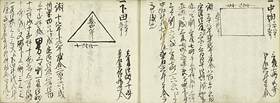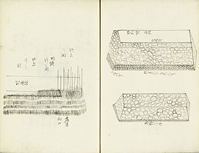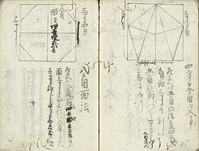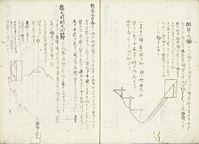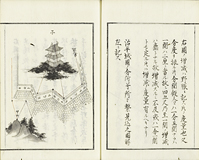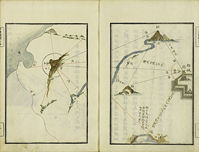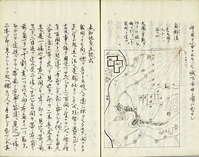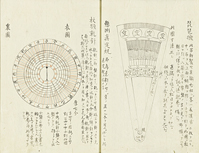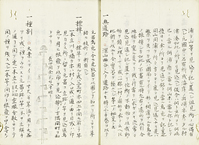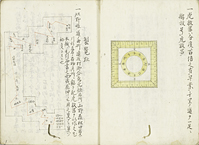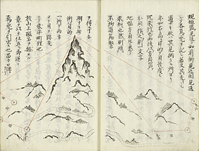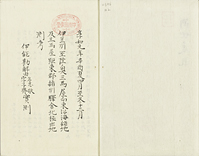4. Wasan related to Practical Science and Surveying
This section introduces materials that indicate Wasan's role in practical science, which was another feature of Wasan.
The materials related to bureaucrats and craftsmen introduce managing manuals for land surveys that were carried out to obtain basic information for levies, verbatim notes that seem to have been written with inspiration of carpenters' skills, and manuals required for civil engineering work.
In addition, we select survey methods as a typical field to which mathematics was directly applied, and introduces a group of manuscripts in the field owned by the National Diet Library. Particularly, the Sokuchido setsu listed last is extremely notable as a material related to Ino Tadataka.
Bureaucrats and Craftsmen
1 Kenchi sanpo hihon
Ms. 1 v. <198-350>
What was considered important as a means of taxation in early modern age in Japan was the land tax, which centered on rice. Bureaucrats needed to understand the shapes of agricultural lands and grades of crops in their villages to confirm the levies of land taxes. At the beginning of the book, it describes calculations of the areas of the fields required to calculate these land taxes. The second half includes calculation exercises prepared by the author who wrote this memorandum and summarizes in places the arithmetic and data knowledge required for land surveys. We could infer from the fact that the era name of "Ansei" in the last days of the Tokugawa regime is occasionally mentioned in the main text that it was a notebook that continued to be written in at that time.
2 Sanpo fushin tebikishu
Ms. 3 v. <211-402>
The class of bureaucrats during the Edo period had to be familiar with businesses related to "Land surveys" as described in the previous material, and with the content of the material Sanpo fushin tebikishu introduced here, as case examples of practice of local governance. The outline of civil engineering work required at that time concerns construction; and this book summarizes how to build banks and how to repair them when they collapse, and how to construct bridges and dams. It provides explanations about basic arithmetic formulae required for building such constructions throughout the text. The author is unknown, but we can infer that the knowledge passed down among the class of bureaucrats that engaged in such construction had been organized in this form. It is not a Wasan book in the pure sense of the word, but it is one of a few materials that indicate how arithmetic and civil engineering techniques were related in those days. In the afterword, we see "Ansei 4" (1857).
3 Banjo sanpo kikigaki
Ms. 1 v. <119-131>
This is a manuscript whose author and completion year are both unknown.
"Banjo" in the title refers to a carpenter. This book describes exercises of cutting out parts of an appropriate shape from timber. (Some parts were removed because they might contain a flaw.) For example, it illustrates dimensions with examples when a regular pentagon, regular octagon, etc., are cut out from a square piece of timber.
It is unusual for knowledge of Wasan believed to have been used in construction fields and the making of joinery structures to be formally preserved, but we can gain a hint through the calculation methods used among craftsmen that we learn of from memoranda collecting special exercises, like this book.
Surveying
- Shimizu-school chokenjutsu (surveying)
-
4 Kiku genpo betsuden
Mentioned by Shimizu Sadanori. Noted by Ishida Keijo. Ms. 1 v. <140-201>This book is a practical guide to the Shimizu-school chokenjutsu (surveying) started by Shimizu Sadanori (1645-1717). More precisely, it was not written by Shimizu Sadanori, but it is a manuscript that was created by one of his disciples, organizing what was written down. It mainly provides explanations for the terms used in the Shimizu school.
During the seventeenth century, the Shogunate ordered Daimyo (feudal lords) across Japan on several occasions to create "Kuniezu" (ancient regional maps drawn per region). This increased the demand for surveying and provided an opportunity for geographical surveyors like Shimizu to spread their techniques to a national level.
The surveying of the Shimizu school described in this book placed a central focus on the technique now called plane-table surveying. This is a technique whereby one places a sheet of paper on a board set horizontally, and directly copies geographical features on the paper on a smaller scale. It is thought that the Japanese learnt this technique from the Dutch.
-
5 Kiku yoho kuden shiroku
Ed. by Kawahara Sadayori. Ms. 9 v. <212-54>The Shimizu-school chokenjutsu was divided into several branches throughout the Edo period; a set of manuscripts (nine volumes) introduced here include what was passed down from Shimizu Sadanori to Kawahara Sadayori (1665-1743) in Shinano and to Murata in Ise. The owner of these manuscripts was Watanabe Ishin (1795-?), a Wasan scholar in the last days of the Tokugawa regime.
Every time this chokenjutsu was passed down, it was improved and modified and the explanation of each tool became more detailed. In addition to survey practice by plane-table surveying and surveying with a Kikugenki (direction finder), it explains how to use Bundo no kane in drawing. It is a material that indicates the consummation reached by a Japanese-style survey technique at the stage before Ino Tadataka imported the Western surveying at the end of the eighteenth century.
- Knowledge derived from Holland
-
6 Bundo yojutsu
By Matsumiya Kanzan. Ms. 6 v. <139-77>The author Matsumiya Kanzan (1686-1780), known as a Hojo-school strategist, had communications with Takebe Katahiro (1664-1739), a Wasan scholar; this book Bundo yojutsu is compiled from a combination of survey techniques and astronomy using knowledge he obtained through experience.
This book includes quotations from the Chinese books on military science, survey techniques from Holland, the results of astronomy taught by Takebe, etc., in a random order. The basic pillar is Hojo-school military science and the survey techniques required for it, but as the book includes knowledge from Holland, China, and Wasan, it is not clear what exactly Matsumiya was aiming. In contrast, he vividly unfolded his erudition and extensive knowledge and how freely he combined them through this book. We could also say that it embodies a momentum of esteeming the practical science that emerged in the Kyoho era in the beginning of the seventeenth century.
-
7 Hiden chiiki zuho taizen
By Hosoi Kotaku. Ms. 1 v. <213-193>The author Hosoi Kotaku (1658-1736) is also known as a chirographer, and was familiar with chokenjutsu. This book, Hiden chiiki zuho taizen, aggregates the knowledge he had garnered through learning since his youth and the results from practice through inspection tours in rural areas he later joined as a vassal of Yanagisawa Yoshiyasu (1658-1714).
What Hosoi particularly emphasizes in this book is the excellence of the survey techniques and the art of navigation transmitted from Holland. While Bundo yojutsu described in the previous section also summarizes contemporary chokenjutsu, Hosoi provides explanations only on chokenjutsu derived from Holland. The outdoor survey techniques, mainly plate-table surveying, and tips for drawing maps are explained with the help of many figures. Also describing the lineage of the Dutch-style chokenjutsu schools down to Hosoi, it provides valuable information for studying the history of surveying in Japan.
-
8 Hiden chiiki zuho daizensho
By Hosoi Kotaku. Ms. 3 v. <W386-N4>Please refer to the previous section. The book in the previous section consists of one volume (the first volume), while book consists of three volumes: the first book, the second book, and the appendix to the second book. The appendix introduces tools related to surveying and astronomy, some of which can be manipulated through paper mechanisms, an area of interest to today's viewers.
-
9 Kokuzu keiyo
Originally written by Miyai Yasuhiro Ms. 1 v. <229-116>The author Miyai Yasuhiro (1760-1815) was a Wasan scholar in Kanazawa. This book is compiled from techniques when creating "Kuniezu" (ancient regional maps drawn per region) as part of Dutch-style chokenjutsu. It simply organizes the points in each item concisely without any illustrations.
Dutch-style chokenjutsu, differing in lineage from that of Shimizu Sadanori, was transmitted to Kanazawa, and spread widely over the areas of the current Ishikawa Prefecture and Toyama Prefecture. Particularly, Ishiguro Nobuyoshi (1760-1836), a Wasan scholar in Toyama, from the lineage of Miyai improved this chokenjutsu in his own way, and produced the prototypes of some survey tools.
-
10 Kiku genpo 1
Ms. 1 v. <W386-4>The author and completion year of this book are both unknown. The content is compiled from Dutch-style chokenjutsu, and as we cannot find any books belonging to the same lineage as this book even when comparing it with the similar books, we can say it is a rare book. We also notice some traces of comparing several manuscripts against each other in terms of content; and we can infer from this that someone who was involved in imparting the chokenjutsu created this manuscript on purpose.
Kobayashi Hyappo (1804-1887), who is described as the original owner of this manuscript, was a Wasan scholar in Echigo in the last days of the Tokugawa regime. The Zuho sanbushu in the next section was also formerly owned by Kobayashi, and we assume that these two books formed a single set.
-
11 Zuho sanbushu 2
Ms. 1 v. <W386-5>This is the transcript that forms a set with the Kiku genpo in the previous section. Similarly, the former owner of this manuscript was Kobayashi Hyappo.
This book includes not only Zuho sanbushu as indicated in the title, but also other contents such as Kiku genpo choken kajo and Kiku genpo betsuden, and provides the basic content of Dutch-style chokenjutsu. Similarly to Kiku genpo in the previous section, it includes a few explanations, etc., that cannot be found in other similar works, and this manuscript that occupies a special position in the field of Dutch-style chokenjutsu.
- Ino Tadataka
-
12 Sokuchido setsu
Ms. 3 v. <W386-N2>This book lists the altitudes of the Pole Star as measured by Ino Tadataka (1745-1818) in eastern Japan (hokkyoku dechi: to find the latitude of a place by measuring the altitude of the Pole Star) per survey journey. Ino was originally interested in astronomy before he ventured to start surveying the entire Japan, for which he is famous. In those days, the most controversial problem was what distance one degree of latitude was equivalent to in the neighborhood of Japan. To measure that distance, he started to make a survey of the eastern Japan.
Ino's autograph manuscripts, etc., are housed in the Ino Tadataka Museum (in Chiba Prefecture), and this book is the manuscript that was owned by Ezawa Nobuaki, a Wasan scholar in the last days of the Tokugawa regime. An envelope addressed to Ezawa with the joint names of Shibusawa Eiichi (1840-1931) and Watanabe Hiromoto is added to the book.

